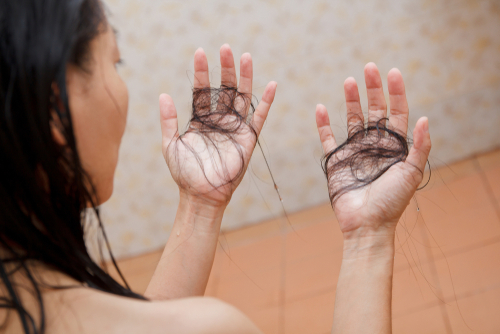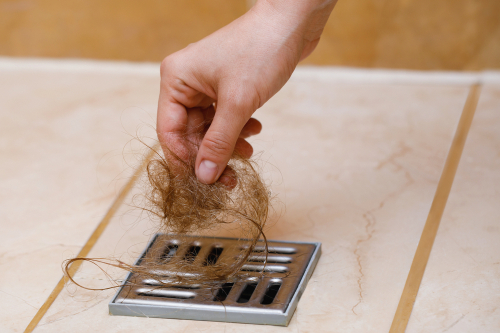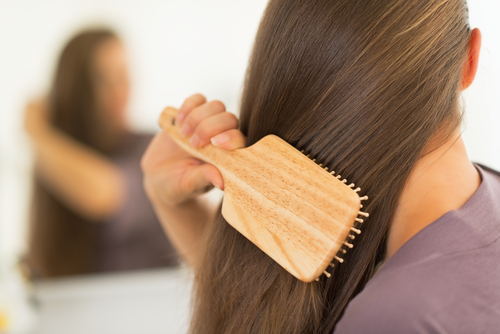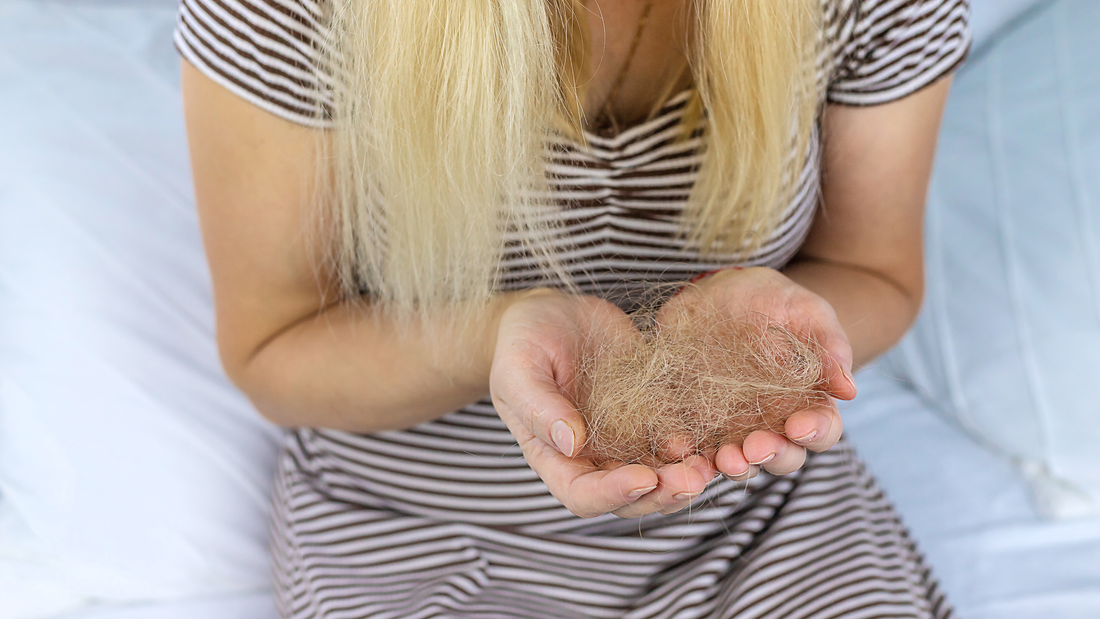Summary
- It's normal to lose between 50 and 100 hairs per day—anything more may indicate abnormal hair loss that requires treatment.
- There are various causes of hair loss, including stress, diet, autoimmune disorders, certain medications, genetic predisposition, and hair loss conditions, such as alopecia areata.
- If you're experiencing excessive hair shedding, speak to a licensed clinician about treatment and to diagnose possible medical conditions.
- Depending on the severity of your hair loss, noninvasive or surgical hair loss solutions exist.
Androgenic alopecia is the most common form of hair loss and affects up to 50% of men and women worldwide.
A variety of factors affect hair loss, such as age, illness, stress, trauma, childbirth, hair treatments, and even certain hairstyles.
In most cases, hair loss can be slowed down or treated with professional help and the right interventions.
Some hair loss is unavoidable, but being able to tell the difference between normal and excessive hair loss can help you find the right treatment.
In this article, we’ll take a look at what causes hair loss, as well as the symptoms and treatment options.
Read on to discover what can trigger hair loss and how you can prevent your hair from falling out in clumps.
Is It Normal to Lose Hair?
According to the American Academy of Dermatology (AAD), it’s completely normal to shed 50 to 100 hairs each day. This can happen while you sleep, or during daily activities, such as brushing your hair or taking a shower.
Anyone who loses significantly more than 100 strands of hair per day may be suffering from telogen effluvium or excessive hair shedding.
People can develop this condition in response to physical or emotional stress.
There is also hair loss, which is different from hair shedding as it occurs when certain factors stop the hair from growing. Anagen effluvium is the official medical term for hair loss.
In the section below we’ll explain how you can tell whether you’re experiencing normal hair loss or something more serious.

Normal Hair Loss vs. Abnormal Hair Loss: What Are the Differences?
Normal hair loss or shedding is easy to distinguish from abnormal hair loss. We’ve put this table together to help you tell them apart.
| Normal Hair Loss or Shedding | Abnormal Hair Loss |
| You lose between 50 and 100 hairs per day. In other words, the strands you lose on your pillow or when you brush your hair are very few.* | You lose more than 100 hairs per day.* |
| The thickness of your hair remains unchanged. | Visible thinning of the hair or bald patches. |
| Hair is lost mainly when the scalp is stimulated, such as when you brush your hair or when you take a shower. | Your hair falls out suddenly instead of over a period of time. |
| There is no hair loss on other parts of the body. | Hair loss on parts of the body other than the scalp—for example, the eyebrows and eyelashes. |
| Additional symptoms accompany hair loss, such as weight loss or fatigue. |
__ How Can I Tell How Much Hair I'm Losing?__
Conducting a hair pull test is an easy way to figure out whether your hair loss is abnormal.
To perform the pull test:
Do not shampoo your hair a day before performing the test. Grip a clump of hair (about 20 to 50 stands) near your scalp. Be gentle, but still firm and pull the hair away from the scalp. Let hairs that remain rooted to your scalp pass through your fingers, but ensure you're pulling firmly enough that loosened hair will remain behind in your hand.
How to interpret the results of the hair pull test:
If around 2-5 hairs are pulled out, this is considered normal (and you are probably only losing between 50 and 100 hairs per day). If you suffer from abnormal hair loss, you will lose up to four times more hair during the test than someone with healthy hair. Generally speaking, if you lose more than 10% of the hair during the test, you have a positive result which could indicate one or more hair loss conditions (and you are probably losing much more than 100 hairs per day).
What Are Some Serious Symptoms of Hair Loss?
There are a few serious symptoms of hair loss that can indicate underlying health conditions that require medical treatment.
Some of these symptoms include:
- Hair loss accompanied by a rash or scalp pain.
- Losing hair elsewhere on your body.
- An itchy or irritated scalp.
- Hair loss accompanied by fatigue.
Is It Okay to Lose Hair in the Shower?

Hair loss may be more noticeable during a shower as wet hair is more prone to breakage than dry hair.
Additionally, your scalp is stimulated when you wash your hair and this may encourage hair shedding.
Some other factors that influence hair loss in the shower include:
- Hair thickness: The more hair you have, the more strands you can lose per day.
- How frequently you shower: If you’ve missed a few days of washing your hair, you may notice more hair shedding than usual the next time you shower.
- How often you comb your hair: If, for example, your hair is typically tied up or you don’t brush it every day, you may notice more hair shedding the next time you comb it out.
Why Is My Hair Falling Out In Clumps: Causes
Natural shedding happens every day, and it’s no cause for concern. But rapidly thinning hair or excessive shedding may be serious and it can be caused by one or more factors.
Once you know how lifestyle factors, such as stress, affect the hair growth cycle, you can take steps to heal your hair follicles and prevent further hair loss.
Stress or trauma
Any stressful or traumatic occurrence can cause hair loss.
If your hair falls out after a tragic event, such as the death of someone close to you, or in response to physical trauma, such as surgery, it’s possible to regrow this hair once your stress levels are under control.
Hair loss caused by stress may only happen months after a traumatic event, so it can be difficult to identify stress as the cause of lost hair.
Diet
An imbalanced diet can affect many bodily processes, including hair growth. Protein and vitamin deficiencies can seriously impact hair health and even cause hair loss over time.
Some important vitamins for managing hair loss include iron, vitamin D, vitamin E, zinc, and biotin.
In addition, fatty acids (omega-3 and omega-6) contribute to hair follicle health by protecting your scalp.
Androgenic alopecia (male and female pattern baldness)
Androgenic alopecia is a clearly defined type of hair loss that occurs in both men and women.
In men, androgenic alopecia can take the form of bald patches, a receding hairline, and hair thinning at the crown.
This type of hair loss is a result of genetics. Your hair follicles are predisposed to the affects of androgen hormones like testosterone and dihydrotestosterone (DHT), which bind to hair follicles and stunt their growth.
Women with androgenic alopecia may experience hair falling out or thinning across the entire scalp, as opposed to experiencing patches of baldness.
Total baldness for women with this condition is rare.
Women with androgenic alopecia also have an increased risk of developing polycystic ovarian syndrome (PCOS), which is characterized by hormonal imbalances that could be related to:
- Irregular menstrual cycles.
- Breakouts and acne.
- Excess hair growth on the body.
- Weight gain.
Alopecia areata
People with alopecia areata experience hair loss because their immune system attacks their hair follicles, causing clumps of hair to fall out.
This type of hair loss may be affected by genetics (you are more prone to developing it if it runs in the family), and people with allergies and autoimmune diseases also have an increased risk of developing it.
There are three types of alopecia areata, namely:
Patchy alopecia areata
This is the most common form of alopecia. It’s characterized by hair loss on the scalp and or body, in coin-sized patches.
Alopecia totalis
Alopecia totalis is characterized by total hair loss on the scalp. Most people affected by this condition will not be able to regrow their hair.
Alopecia universalis
This rare form of alopecia results in complete or near-complete loss of hair on the scalp and the body.
Scarring alopecia
If the hair follicle is completely destroyed, scarring alopecia can occur. This permanent form of hair loss is caused mainly by inflammation and it is irreversible once the scar has formed.
Inflammatory conditions or trauma—such as burns or serious infections—can cause scarring alopecia.
Thyroid disorder
The thyroid gland releases hormones that control a variety of bodily functions. Thyroid dysfunction therefore affects the hair growth cycle.
Both an overactive and underactive thyroid may cause hair loss. Once thyroid levels have normalized, hair regrowth is usually possible.
Autoimmune disorders
Autoimmune diseases occur when the immune system mistakenly attacks healthy body tissues.
Lupus, rheumatoid arthritis, Crohn’s disease, and psoriasis are some autoimmune disorders that can lead to hair loss.
Once the autoimmune condition is treated, hair can grow back.
Certain medications
There are several medications that can cause hair loss, though hair often regrows after the person stops the treatment.
In some cases, like with cancer patients undergoing chemotherapy, it’s not possible to stop medication use and temporary hair loss may occur.
Some other medications that can cause hair loss include:
- Antidepressants.
- Beta blockers.
- Retinoids.
- Anticoagulants (medicine that prevents blood clots).
- Antithyroid medication.
- Arthritis medications.
- Allopurinol (gout medication).
- Levodopa (used to treat the symptoms of Parkinson’s disease).
What Should I Do If My Hair Is Falling Out in Clumps?
Don’t panic. Chances are the condition is temporary or curable with the right medication and self-care.
Treat your hair gently
It goes without saying: if your hair is thinning or falling out, you don’t want to risk losing more hair or causing further damage to the hair follicles.
To reduce hair shedding, implement a gentle hair care routine. This may include:
- Not pulling or tugging at your hair while brushing or washing it.
- Using a mild shampoo.
- Avoiding dyeing your hair or styling it with heat.
- Avoiding tight hairstyles and chemical treatments.
- Using hair accessories that are gentle and minimize hair breakage.

Visit a doctor
A licensed clinician will be able to diagnose the cause of your hair loss and suggest treatment options.
If your doctor or dermatologist suspects that an underlying health issue, infection, nutritional deficiency, or hormone imbalance is the reason for your hair loss, they may conduct a blood test or a biopsy.
Get treatment for hair loss
There are several treatments for hair loss available, including noninvasive and surgical options.
Depending on the severity of your hair loss, the cause, and the results you’re looking for, you can choose one or more of the following treatments:
- Over-the-counter medications like DHT-fighting shampoos and conditioners, or the only FDA-approved topical, minoxidil
- Prescription medications like oral finasteride
- Hair transplant surgery
- Laser therapy
- Vitamin supplementation/dietary adjustments if appropriate
At Shapiro MD, we carry a wide range of effective over-the-counter and prescription medications that can be prescribed online by licensed clinicians, if appropriate. No matter your situation, we’ve got something that fits.
When Should I See a Doctor for Hair Loss?
Rapid hair loss can be a really stressful experience. Let’s face it: no one wants to see tufts of hair lying in the shower stall or on their pillow in the morning.
Seeing a few strands of hair on a brush is normal. However, if your hair loss becomes obvious—for example, there are bald patches on your scalp or you experience hair thinning—it’s best to seek professional advice.
If you experience other symptoms in addition to hair loss, such as rapid weight loss and fatigue, you should visit your doctor to rule out any underlying health conditions.
To reduce your chances of permanent hair loss, you should seek treatment as soon as possible.
Don’t feel like visiting a doctor? Get in touch with one of our licensed clinicians from the comfort of home. Answer a few easy questions to get started on your journey to healthier hair.
Where Can I Learn More about Hair Loss?
Have you been seeing too much hair on your brush? Are the clumps on the cubicle floor causing you to worry?
If you’re concerned that you may be suffering from female or male pattern baldness, Shapiro MD has got you covered.
Whether you’re struggling with a receding hairline, battling to regrow your hair after a traumatic life event, or simply trying to prevent hereditary hair loss, we have the products and expertise to help you reach your goals.
Visit our blog to learn more about hair loss causes and solutions, or get in touch with one of our clinicians for a personalized hair loss treatment plan. Take our free quiz to get started.
To learn more about hair growth and hair loss prevention, visit Shapiro MD today.
For more information on our products and services, pop us an email or give us a call directly at [(877) 907-4047](tel:(877) 907-4047).




